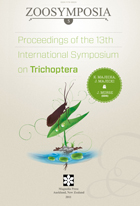Abstract
Long-term studies of the life cycle of Chaetopteryx villosa (Fabricius) have been conducted in Wolbórka Spring, in the vicinity of Łódź (Central Poland). The emergence period of adults lasts from the beginning of October until mid December. During this relatively long period, adults are exposed to diverse weather conditions. Low (sometimes below zero) ambient temperatures influence the survival of adults. Although oviposition usually starts at the end of October, freshly laid eggs were found even in January. These temperatures also determine the activity of predators as well as the development and survival of eggs laid on land. Some egg masses have been transferred to the laboratory and bred at different temperatures.

